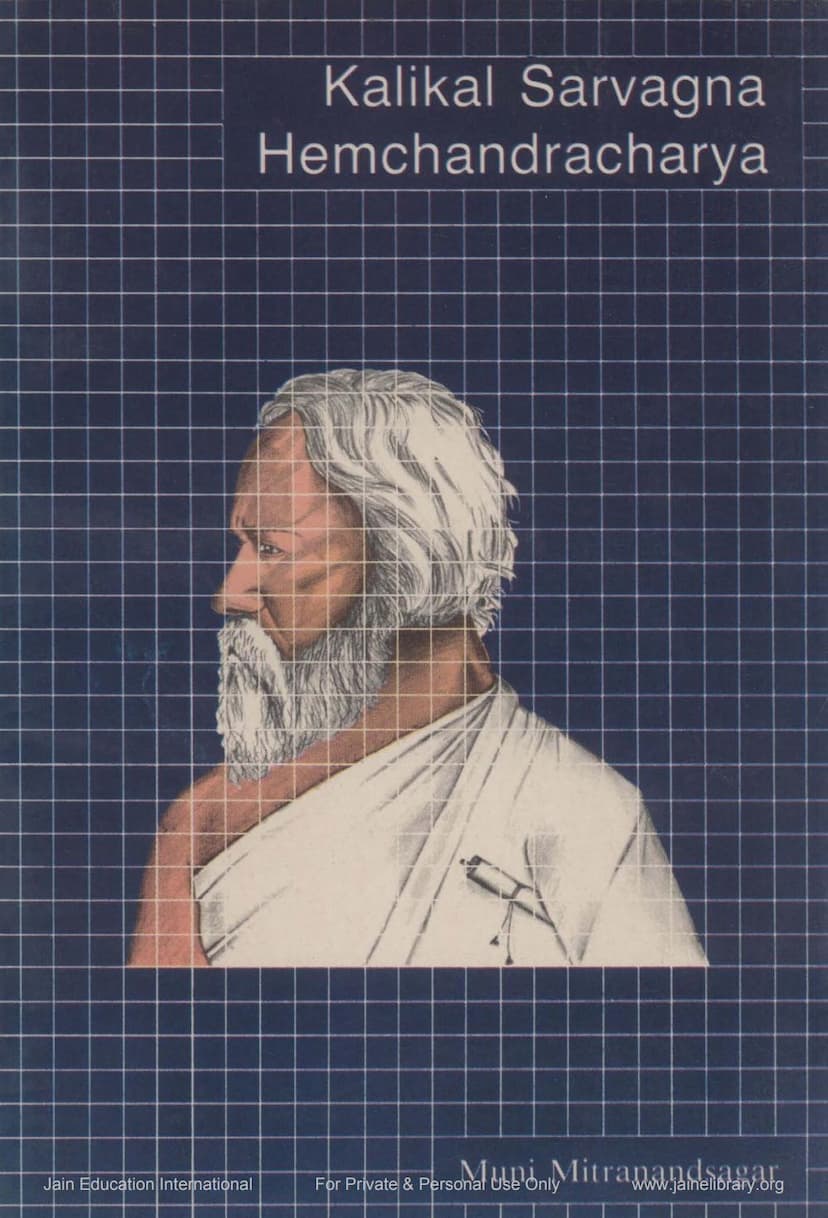Kalikal Sarvagna Hemchandracharya
Added to library: September 2, 2025

Summary
Here's a comprehensive summary of the Jain text "Kalikal Sarvagna Hemchandracharya," based on the provided pages:
Book Overview:
"Kalikal Sarvagna Hemchandracharya" is a biography of the highly influential Jain Acharya Hemchandrasoori, written by Muni Mitranandsagar and translated into English by Dr. Rashmikant Shah. Published by Manav Mangal, Bombay, it aims to illuminate the life and multifaceted contributions of this remarkable historical figure.
Core Message and Theme:
The book emphasizes that true greatness is not born from birth, position, or wealth, but from a life of dedication to good thoughts and actions, a noble and pious existence. Acharya Hemchandrasoori is presented as the embodiment of this principle, a scholar-saint who transcended sectarian boundaries and worked for the welfare of all mankind.
Key Aspects of Acharya Hemchandrasoori's Life and Work:
-
Early Life and Calling:
- Born Changdev in Dhandhuka, Gujarat, in 1089 AD, to a merchant family.
- Even as a child, he displayed extraordinary intellect and was recognized by Acharya Devchandrasoori as a destined great Acharya of Jainism.
- Despite his mother's initial hesitation due to her attachment and his father's non-Jain background, Changdev himself expressed a desire for spiritual initiation.
- He was formally initiated at the age of eight, renamed Muni Somchandra, and quickly mastered various subjects like poetry, logic, and literature.
- His quest for knowledge led him to seek blessings from Goddess Saraswati, who appeared to him and confirmed his destiny.
-
Rise to Acharyaship and Influence:
- At the young age of 21 (1110 AD), Muni Somchandra was elevated to the position of Acharya and renamed Acharya Hemchandrasoori.
- His rational approach, practicality, and broad outlook made him popular and respected across society, attracting scholars and prominent individuals.
- He developed a strong and lifelong relationship with King Siddharaj Jaysimh of Gujarat, who was deeply impressed by his wisdom and presence of mind.
-
Literary and Scholarly Contributions:
- Acharya Hemchandrasoori is celebrated for his vast literary output, described as possibly amounting to thirty-five million shlokas.
- His most significant work is Siddha-Hem-Shabdanushasan, a comprehensive Sanskrit grammar that also included a section on Prakrit grammar. This work is considered a landmark in Indian literature and is noted for its completeness and self-sufficiency.
- He also wrote extensively on Kosh Sahitya (lexicography), including works like Abhidhan Chintamani, Shesh Nam mala, Anekarth Nam mala, Deshi Nam mala, and Nighantu Kosh, which are invaluable for understanding word meanings and etymology.
- His Dwyashray Kavya (Sanskrit and Prakrit) are epic poems that simultaneously chronicle the history of the Choulukya dynasty and illustrate grammatical rules, showcasing his mastery of both literature and linguistics.
- Other significant works include Chhandonushasan (prosody), Kavyanushasan (poetics), Yogashastra (spiritual upliftment), Pramana-Mimamsa (logic), Trishashti-Shalaka-Purush-Charitram (biographies of sixty-three great Jain figures), and Parishishta Parva (lives of Jain Acharyas).
- His literature is praised for its depth of thought, clarity, logical reasoning, originality, and balanced judgment, making it relevant and valuable even today.
-
Key Incidents and Demonstrations of Wisdom:
- King Siddharaj's Welcome: Acharya Hemchandrasoori's presence of mind in a royal procession, where he offered a Sanskrit verse to enable the king's elephant to pass, deeply impressed Siddharaj, leading to their close association.
- The Grammar Compilation: Commissioned by Siddharaj to write a new Sanskrit grammar, Hemchandrasoori compiled Siddha-Hem-Shabdanushasan, a monumental work that became the standard for studying Sanskrit and Prakrit.
- The Pandav Debate: When questioned by Brahmin pandits about the Jain belief that Pandavas attained salvation on Mount Shatrunjay, Acharya Hemchandrasoori used a verse from the Mahabharata itself to demonstrate that the epic mentions the cremation of hundreds of Pandavas, thus validating the existence of other Pandavas who might have achieved salvation at Shatrunjay. This incident highlights his broad knowledge and ability to use opposing arguments to his advantage.
- The Somnath Pilgrimage: Invited by King Kumarpal (Siddharaj's successor) to a pilgrimage at the Hindu shrine of Somnath, Acharya Hemchandrasoori recited verses that honored the divine in any form, regardless of religious affiliation, proving his inclusive and tolerant approach. He stated, "Anyone whose loves and hatred... have been destroyed—I bow to him, may he be Brahma, Vishnu, Mahadev or Jineshwar."
-
Impact on Kings and Society:
- Acharya Hemchandrasoori played a pivotal role in bringing rulers like Siddharaj Jaysimh under the influence of religion.
- He was instrumental in the conversion of King Kumarpal to Jainism, who subsequently became known as 'Param Arhat' (the best Jain householder). Kumarpal's reign is considered a golden age for Sanskrit-Prakrit literature, largely due to the Acharya's guidance.
- His philosophy of Ahimsa (non-violence) was widely spread, significantly influencing society.
-
Legacy:
- Acharya Hemchandrasoori is rightfully called "Kalikal Sarvagna" (the Omniscient of the Kali Yuga) due to his unparalleled intellectual prowess and vast contributions across various fields.
- His period of influence is sometimes referred to as the "Hem Yuga" (Hem's Era).
- Indology and Jain studies are considered incomplete without studying his writings.
- He left his mortal body in Patan in 1173 AD at the age of 84.
- The book concludes by emphasizing the enduring need for such a great saint, scholar, poet, literateur, and philosopher in the present day.
In essence, the book portrays Acharya Hemchandrasoori as a universal figure whose life and work continue to inspire with their intellectual depth, spiritual guidance, and commitment to the welfare of all beings.